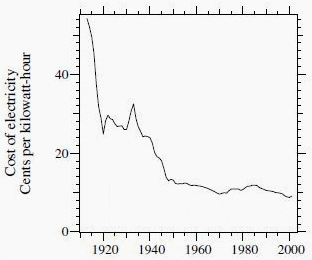Electrification //
Electrification in the early 20th century dramatically improved productivity and increased the well-being of the industrialized world. No longer a luxury – now a necessity – electricity powers the machinery, the computers, the health-care systems, and the entertainment of modern society.
Given its benefits, electricity is inexpensive, and its price continues to slowly decline (after adjusting for inflation — see Figure 1.1).

Electric power distribution is the portion of the power delivery infrastructure that takes the electricity from the highly meshed, high-voltage transmission circuits and delivers it to customers. Primary distribution lines are “medium-voltage” circuits, normally thought of as 600 V to 35 kV. At a distribution substation, a substation transformer takes the incoming transmission- level voltage (35 to 230 kV) and steps it down to several distribution primary circuits, which fan out from the substation.
Figure 1.2 shows an overview of the power generation and delivery infrastructure and where distribution fits in. Functionally, distribution circuits are those that feed customers (this is how the term is used in this book, regardless of voltage or configuration). Some also think of distribution as anything that is radial or anything that is below 35 kV.
The distribution infrastructure is extensive; after all, electricity has to be delivered to customers concentrated in cities, customers in the suburbs, and customers in very remote regions; few places in the industrialized world do not have electricity from a distribution system readily available. Distribution circuits are found along most secondary roads and streets. Urban construction is mainly underground; rural construction is mainly overhead. Suburban structures are a mix, with a good deal of new construction going underground.

A mainly urban utility may have less than 50 ft of distribution circuit rfor each customer. A rural utility can have over 300 ft of primary circuit per customer. Several entities may own distribution systems: municipal governments, state agencies, federal agencies, rural cooperatives, or investor-owned utilities. In addition, large industrial facilities often need their own distribution systems. While there are some differences in approaches by each of these types of entities, the engineering issues are similar for all.
For all of the action regarding deregulation, the distribution infrastructure remains a natural monopoly. As with water delivery or sewers or other utilities, it is difficult to imagine duplicating systems to provide true competition, so it will likely remain highly regulated. Because of the extensive infrastructure, distribution systems are capitalintensive businesses.
An Electric Power Research Institute (EPRI) survey found that the distribution plant asset carrying cost averages 49.5% of the total distribution resource (EPRI TR-109178, 1998). The next largest component is labor at 21.8%, followed by materials at 12.9%. Utility annual distribution budgets average about 10% of the capital investment in the distribution system.
On a kilowatt-hour basis, utility distribution budgets average 0.89 cents per kilowatt-hour (see Table 1.1 for budgets shown relative to other benchmarks).
TABLE 1.1 – Surveyed Annual Utility Distribution Budgets in U.S. Dollars
| Average | Range | |
| Per dollar of distribution asset | 0.098 | 0.0916–0.15 |
| Per customer | 195 | 147–237 |
| Per thousand kWH | 8.9 | 3.9–14.1 |
| Per mile of circuit | 9,400 | 4,800–15,200 |
| Per substation | 880,000 | 620,000–1,250,000 |
Low cost, simplification, and standardization are all important design characteristics of distribution systems. Few components and/or installations are individually engineered on a distribution circuit. Standardized equipment and standardized designs are used wherever possible.
Planning goals are to provide service at low cost and high reliability. Planning requires a mix of geographic, engineering, and economic analysis skills. New circuits (or other solutions) must be integrated into the existing distribution system within a variety of economic, political, environmental, electrical, and geographic constraints.
The planner needs estimates of load growth, knowledge of when and where development is occurring, and local development regulations and procedures.











Quite informative…!
If i found anything to be, I’ll let you know.
this is important for your comming electricity nill in your Home. overall cost of n’th unit cost.
your electricity bill comming in unit, how!?
a m from indonesia follower electrical,i am newer
Lots of good